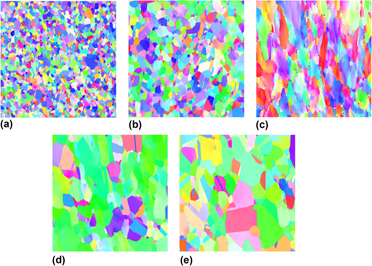Crossref Citations
This article has been cited by the following publications. This list is generated based on data provided by
Crossref.
BI, Sheng
YUN, Xin-bing
PEI, Jiu-yang
ZHAO, Ying
YAN, Zhi-yong
and
ZHANG, Xu
2017.
Microstructure evolution of Al–Sr master alloy during continuous extrusion.
Transactions of Nonferrous Metals Society of China,
Vol. 27,
Issue. 2,
p.
305.
Li, Bing
Lin, Zikai
Peng, Cheng
Wang, Xue
and
Zhang, Jingfeng
2017.
Characteristics of microstructure evolution of two-phase H62 brass alloy during continuous extrusion.
Procedia Engineering,
Vol. 207,
Issue. ,
p.
1123.
Yuan, Yuan
Li, Zhou
Xiao, Zhu
Zhao, Ziqian
and
Yang, Ziqi
2017.
Microstructure evolution and properties of Cu-Cr alloy during continuous extrusion process.
Journal of Alloys and Compounds,
Vol. 703,
Issue. ,
p.
454.
Yuan, Yuan
Li, Zhou
Xiao, Zhu
and
Zhao, Ziqian
2017.
Investigations on Voids Formation in Cu–Mg Alloy During Continuous Extrusion.
JOM,
Vol. 69,
Issue. 9,
p.
1696.
Asfandiyarov, Rashid N.
Raab, Georgy I.
and
Aksenov, Denis A.
2020.
Study of the Combined Severe Plastic Deformation Techniques Applied to Produce Contact Wire for High-Speed Railway Lines.
Metals,
Vol. 10,
Issue. 11,
p.
1476.
Ma, Muzhi
Zhang, Xi
Li, Zhou
Xiao, Zhu
Jiang, Hongyun
Xia, Ziqi
and
Huang, Hanyan
2020.
Effect of Equal Channel Angular Pressing on Microstructure and Mechanical Properties of a Cu-Mg Alloy.
Crystals,
Vol. 10,
Issue. 6,
p.
426.
Shen, Zhe
Lin, Zhongze
Shi, Peijian
Tang, Ganpei
Zheng, Tianxiang
Liu, Chunmei
Guo, Yifeng
and
Zhong, Yunbo
2021.
Enhanced strength, ductility and electrical conductivity of Cu–Te alloys via dynamic recrystallization and precipitation.
Materials Science and Engineering: A,
Vol. 820,
Issue. ,
p.
141548.
Zhao, Qingkun
Yang, Huiya
Liu, Jiabin
Zhou, Haofei
Wang, Hongtao
and
Yang, Wei
2021.
Machine learning-assisted discovery of strong and conductive Cu alloys: Data mining from discarded experiments and physical features.
Materials & Design,
Vol. 197,
Issue. ,
p.
109248.
Hu, Peng-Hong
Song, Hong-WU.
Wang, Song-Wei
Chen, Yan
and
Zhang, Shi-Hong
2021.
Mechanisms of primary phase refinement and toughness improvement of Cu–2 wt% Ag–0.15 wt% La alloy through continuous extrusion forming.
Materials Science and Engineering: A,
Vol. 819,
Issue. ,
p.
141521.
Zhou, Mo
Yun, Xinbing
and
Fu, Hongwang
2022.
Producing large-scale industrially applicable high-precision copper strips by continuous extrusion with a novel U-shaped die.
Journal of Manufacturing Processes,
Vol. 82,
Issue. ,
p.
559.
Shen, Zhe
Lin, Zhongze
Shi, Peijian
Zhu, Jiale
Zheng, Tianxiang
Ding, Biao
Guo, Yifeng
and
Zhong, Yunbo
2022.
Enhanced electrical, mechanical and tribological properties of Cu-Cr-Zr alloys by continuous extrusion forming and subsequent aging treatment.
Journal of Materials Science & Technology,
Vol. 110,
Issue. ,
p.
187.
Bodyakova, Anna
Tkachev, Maksim
Raab, Georgy I.
Kaibyshev, Rustam
and
Belyakov, Andrey N.
2022.
Regularities of Microstructure Evolution in a Cu-Cr-Zr Alloy during Severe Plastic Deformation.
Materials,
Vol. 15,
Issue. 16,
p.
5745.
Chen, Jinshui
Xiao, Xiangpeng
Guo, Chengjun
Yuan, Dawei
Huang, Hao
and
Yang, Bin
2022.
Regulation of primary phase in Cu-Cr-Zr alloy and its effect on nano-structure and properties.
Journal of Alloys and Compounds,
Vol. 926,
Issue. ,
p.
166836.
Desta, Tariku
Sinha, Devendra Kumar
Ramulu, Perumalla Janaki
and
Raja, Vijayanandh
2023.
Mechanical Behavior and Wear Characteristics of a Conform Extruded C18150 (Cu-Cr-Zr Alloy) Rod.
Journal of Engineering,
Vol. 2023,
Issue. ,
p.
1.
Liu, Weijiang
Gao, Xinhe
Zhang, Xuehui
Zhou, Chenyang
Ahmad, Tahir
Wang, Hang
and
Yang, Bin
2023.
Effect of vanadium element on the microstructure and mechanical properties of Cu-3.2Ti-0.2Fe alloys.
Intermetallics,
Vol. 162,
Issue. ,
p.
108005.
Ru, Yadong
Gao, Zhaoshun
Zhang, Ling
Tang, Zhixiang
Zuo, Tingting
Xue, Jiangli
Xiao, Liye
and
Li, Xuebin
2024.
Microstructure and Properties of High Strength and High Conductivity Cu-0.4Mg Alloy Processed by Upward Continuous Casting and Multi-pass Drawing.
Journal of Materials Engineering and Performance,
Vol. 33,
Issue. 10,
p.
5041.
Lee, Isshu
Bhatta, Laxman
Wu, Yun-Hsuan
Daut, Lukas
Figueiredo, Roberto B.
Liss, Klaus-Dieter
Bay, Brian K.
Santala, Melissa K.
and
Kawasaki, Megumi
2024.
The Cold Angular Rolling Process of Copper Sheets: Unraveling Plastic Deformation Behavior and Unveiling Microstructural Transformations.
Advanced Engineering Materials,
Vol. 26,
Issue. 4,



